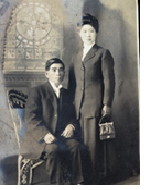From my mother-in-law Mary’s way of writing: Why do we write America as Beikoku?
Yoshie Doi

Pre-war photos found in an album
My mother-in-law’s name was Mery. She was born and raised in America, but returned to Japan during the war. I never thought it was strange to write America as “Beikoku,” but when I learned the spelling “Beikoku,” I understood.
A long time ago, I obtained a copy of my family register and found out that she was born in Washington State, USA, and that her name was written in Japanese kanji. I also found out that her name was written in kanji on my American bankbook.
When Japan opened up to the world with the Meiji Restoration, it began to write European and American countries in kanji. From that time on, ateji characters using the sounds of kanji were used, and America was written as 亜米利加, which was shortened to 米国(Beikoku). England was written as 英吉利, France as 仏蘭西, Germany as 独逸, Italy as 伊太利, Australia as 濠太剌利, Canada as 加奈陀, Turkey as 土耳古, Denmark as丁抹, Sweden as 瑞典, Israel as 以色列, and India as 印度.
As a result, it is still in use today in 米国 the United States, 英国 the United Kingdom, 仏国 France, 独国 Germany, 伊国 Italy, 豪国 Australia, and other countries. When the Nanban people arrived in Japan in the 16th century, Japan’s unique kanji writing system was developed. It is said to have originated from Chinese kanji writing. I was impressed by how interesting the history of kanji writing is, as it reflects the vast capacity and ingenuity of the Japanese language.
For your reference, we have also provided the Chinese spelling of country names in China, which uses Chinese characters. Although the pronunciation is different, there are some country names that are written with the same characters.
| Country | Japanese | Japanese | Chinese |
| America | アメリカ | 米国 | 美国 |
| England | イギリス | 英吉利 | 英国 |
| France | フランス | 仏蘭西 | 法国 |
| Germany | ドイツ | 独逸 | 徳国 |
| Italy | イタリア | 伊太利 | 意大利 |
| Australia | オーストラリア | 濠太剌利 | 澳大利亚 |
| Canada | カナダ | 加奈陀 | 加拿大 |
| Turkey | トルコ | 土耳古 | 土耳 |
| Denmark | デンマーク | 丁抹 | 丹麦 |
| Sweden | スウェーデン | 瑞典 | 瑞典 |
| Israel | イスラエル | 以色列 | 以色列 |
| India | インド | 印度 | 印度 |
In between sorting through the documents, I had the chance to chat with Mery-san, the man in the photo, for the first time in a long while.
The end of document
Translated by Masami Otani
